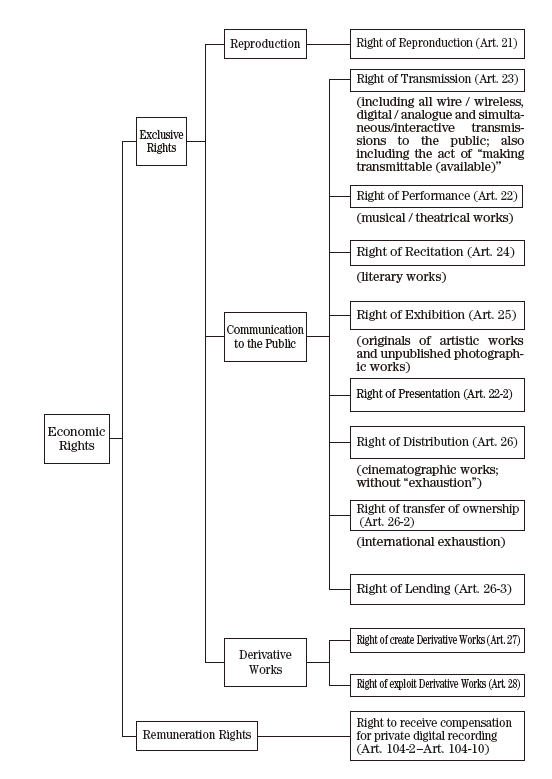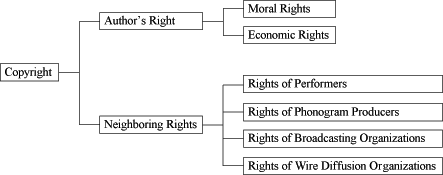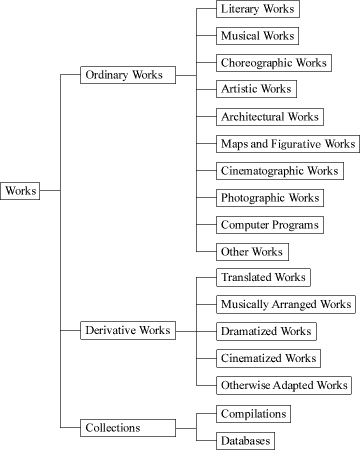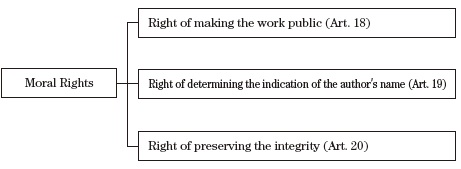|
(b) Economic rights
The Copyright Law provides for the following economic rights of authors.

2. Neighboring Rights
(1) Neighboring Rights Owners and the Scope of Protection
The Copyright Law grants neighboring rights to the following four categories of right owners.

(a) Protected performances (Art.7)
 |
(1) |
performances which take place in Japan |
| (2) |
performances fixed in "phonograms" under protection |
| (3) |
performances transmitted by "broadcasting" or "wire diffusion" under protection |
| (4) |
performances to which Japan has the obligation to grant protection under the Rome Convention or the TRIPS Agreement |
| (5) |
performances which take place in a Contracting Party to the WIPO Performances and Phonograms Treaty |
(b) Protected phonograms (Art.8)
 |
(1) |
phonograms the producers of which are Japanese nationals |
| (2) |
phonograms composed of the sounds which are first fixed in Japan |
| (3) |
phonograms to which Japan has the obligation to grant protection under the Rome Convention, the Phonogram Convention or the TRIPS Agreement |
| (4) |
phonograms the producers of which are nationals of any of the Contracting Parties to the WPPT ("nationals" includes legal persons established under the law of such Contracting Party and those who have their principal offices in such Contracting Party) |
| (5) |
phonograms composed of the sounds which were first fixed in any of the Contracting Parties to the WPPT |
(c) Protected broadcasts (Art.9)
 |
(1) |
broadcasts transmitted by broadcasting organizations of Japanese nationality |
| (2) |
broadcasts transmitted from transmitters situated in Japan |
| (3) |
broadcasts to which Japan has the obligation to grant protection under the Rome Convention or the TRIPS Agreement |
(d) Protected wire diffusions (Art.9-2)
 |
(1) |
wire diffusions transmitted by wire diffusion organizations of Japanese nationality |
| (2) |
wire diffusions transmitted from transmitters situated in Japan |
(2) Neighboring Rights Granted by the Copyright Law
The Copyright Law provides for the following neighboring rights without any formality. The rights granted to foreign phonogram producers, etc. may differ among the countries of origin because of different levels of protection among neighboring rights treaties as well as the different accessions to such treaties among relevant countries of origin.
 |
Performance
(Art.7) |
Phonogram
(Art.8) |
Broadcast
(Art.9) |
Wire
Diffusion
(Art.9 (ii)) |
| Moral Rights |
determining the indication of the performer's name |
o |
- |
- |
- |
| preserving the integrity |
o |
- |
- |
- |
Exclusive
Rights |
fixation |
o |
- |
o |
o |
| reproduction of fixations |
o |
o |
o |
o |
| (re)broadcasting |
o
("live" only) |
- |
o |
o |
| wire (re)diffusion |
o
("live" only) |
- |
o |
o |
interactive transmission
("making transmittable (available)") |
o
("live" and commercial phonogram) |
o |
o |
o |
| transfer of ownership |
o |
o |
- |
- |
rental by commercial phonograms
(the first one year only) |
o |
o |
- |
- |
| public display by enlarging TV |
- |
- |
o |
o |
Remuneration
Rights |
broadcasting or cablecasting of commercial phonograms
(including simultaneous retransmission) |
o |
o |
- |
- |
rental of commercial phonograms
(the remaining 49 years) |
o |
o |
- |
- |
| simultaneous retransmission of the programs which includes live performance by cablecasting organizations |
o |
o |
- |
- |
| simultaneous retransmission of regular broadcast programs by IP multi-cast operators |
o |
o |
- |
- |
|
3. Term of Protection
(1) Author's Right (Art.51)
The protection of economic rights of authors begins at the creation of the work automatically without any formality, and continues until the end of a period of seventy years following his/her death.
However, in the cases where the above rule cannot be applied, the term of protection is for seventy years following the "making public" (the first publication, performance to the public, transmission to the public, etc.) of the work. (If the work is not made public within seventy years following its creation, the term of protection will be seventy years following its creation.)
Economic rights in the following cases continue to subsist until the end of seventy years following the making public of the works :
(a) anonymous and pseudonymous works ;
(b) works bearing the name of a body corporate.
(c) cinematographic works
The calculation of the seventy years starts from the beginning of the year following the author's death, the making public or the creation of the work.
In the case of periodical publications such as newspapers and magazines, the term of protection is calculated from the making public of each volume or issue. However, in the case of works which are made public in parts continually such as serial novels in a magazine, the term of protection is calculated from the making public of the last part.
Some special rules are stipulated on the term of protection, e.g. for works created by foreign nationals. Although they are rather complicated in practice, due attention should be paid when exploiting foreign works. The term of protection of moral rights theoretically expires when the author dies, however, acts which would infringe moral rights are prohibited even after the death of the author.
(2) Neighboring Rights (Art.101)
The term of the protection of neighboring rights is as follows;
Performances: seventy years from the begining of the year following the performance takes place
Phonograms: seventy years from the begining of the year following the first fixation of sounds is made
Broadcasts: fifty years from the begining of the year following the broadcast takes place (for broadcasts)
Wire Diffusions: fifty years from the begining of the year following the wire diffusion takes place
*The term of protection of neighboring rights shall expire at the end of a period of seventy years from the year when the publishing was made or when the first fixation of sounds was made if the publishing has not been made within a period of seventy years following the first fixation of sounds, for phonograms.
4. Limitation on Rights
The purpose of the copyright protection system in Japan is to pursue the development of culture through ensuring the protection of rights of authors and other rightholders. However, one can find other rights/values in the society such as the development of education, art and culture, social welfare, democratic systems, etc., which are deeply related to public interests. Therefore, with a view to ensuring the "balance" between copyright and other rights/values, the Copyright Law provides for limitations on rights for limited and exceptional cases. These provisions are carefully established with strict and detailed conditions so that they may not unreasonably prejudice the interests of right owners. The following are the major examples of such limitations, and it should also be noted that when the author's right is limited, relevant neighboring rights are usually limited, too.
(a) Reproduction for personal use (Art.30)
It is permissible to reproduce a work for the purpose of the user's personal use. Even if it is done personally, the following cases are not permissible.
| • |
reproduction for business (profit-making or non-profit-making) |
| • |
reproduction by means of automatic reproducing machines for public use |
| • |
reproduction which is made by the circumvention of technological protection measures |
| • |
reproduction of music and motion pictures has been downloaded illegal through the internet being aware of infringement |
| • |
reproduction of music and motion pictures has been downloaded illegal through the internet being aware of infringement |
Also, those who make digital sound or visual recordings for the purpose of personal use should pay compensation to the copyright owners, the performers and the phonogram producers concerned, which is in advance added to the prices of digital recording equipments/media.
(b) Exploitation of Incidentally captured works (Art.30-2)
It is permissible to reproduce or adapt works in the case in which works other than
an intended target are recorded as accompaniment by means of photography or by
means of the recording of sounds or visuals. For instance, this exception is applied to
the case in which a painting is photographed on a small scale on the background besides the originally intended target of the photography when a photo is taken. However, it is limited to the case when the works are incidentally captured because it is difficult to separate from the intended target.
Also, an incidentally captured work reproduced in the cases mentioned above may
be exploited, in any way, in connection with the exploitation of the photographic or
recorded work. For instance, posting a photo in which a painting is photographed on
a small scale on the background on a blog page is included.
(c) Exploitation a work as part of the investigation process (Art.30-3)
A person seeking to exploit a work with the authorization of its copyright owner or
after obtaining a compulsory license may exploit that work, in any way and to the
extent deemed necessary, if the purpose is part of the process of investigating exploitation of that work. For instance, this exception is applied to the case in which a
character is shown on a material of a meeting before permission is acquired from the
copyright owner in the course of the planning of the commercialization of a cartoon
character.
(d) Reproduction in and by libraries (Art.31)
It is permissible for libraries to reproduce a work for limited cases and purposes under some strict conditions. In addition, digitization of the materials housed in National Diet Library for the purpose of avoiding damages will be permissible.
(e) Quotations (Art.32)
It is permissible to make quotations from a work as long as it is compatible with fair practices.
(f) Reproduction in school textbooks authorized by the Government (Art.33)
It is permissible to reproduce a work in school textbooks authorized by the national educational authorities, however, the person who carries out such reproduction is to announce it to the author as well as to pay compensation to the copyright owner.
(g) Reproduction for preparing of textbook in digital textbook (Art.33-2)
It is permissible to reproduce a work cited in school textbooks in digital textbooks for learners, however, the person who carries out such reproduction is to announce it to the author as well as to pay compensation to the copyright owner.
(h) Reproduction for preparing of textbook in large print (Art.33-3)
It is permissible to reproduce textbooks in large print or by other means for visually, developmentally pupils who has difficulties in using copyrighted works on textbooks, however, the person who carries out such reproduction is to announce it to the author as well as to pay compensation to the copyright owner.
(i) Broadcasting or wire diffusion in school education programs complying with the National Curriculum Standard (Art.34)
It is permissible to broadcast or diffuse by wire a work in programs for school education consistent with the National Curriculum Standard. However, the person who carries out such transmission is to announce it to the author as well as to pay compensation to the copyright owner.
(j) Reproduction in educational institutions (Art.35)
It is permissible for a person who is in charge of teaching and those who are taught in a school or other educational institutions in formal or informal educational institutions for non-profit-making purpose to reproduce a work to use it in the course of teaching, provided that such reproduction does not unreasonably prejudice the interests of the copyright owners.
It is permissible to make the public transmission of such work intended for reception by those who take lessons at the same time at a place other than that where such lessons are given in the course of such lessons, provided that such transmission does not unreasonably prejudice the interests of the copyright owners.
(k) Reproduction in examination questions (Art.36)
It is permissible to reproduce, or make the public transmission of a work in examination questions, however, if such examination is done for profit-making purposes, provided that such reproduction does not unreasonably prejudice the interests of the copyright owners. The person who carries out such reproduction or transmission is to pay compensation to the copyright owner
(l) Reproduction for people with visual impairments or the like (Art.37)
It is permissible to reproduce a work in Braille and transmit Braille data of a work
publicly through a personal computer network. For Braille libraries and other establishments (designated by Cabinet Order) for the promotion of the welfare of the visually disabled etc. (including physically disabled), it is permissible, solely for the purpose of renting or making automatic public transmission to the visually disabled etc.,
to make sound recordings of a work already made public or make automatic public
transmissions exploiting such sound recordings solely for the visually disabled etc..
(m) Reproduction for the hearing disabled (Art.37-2)
It is permissible for social welfare establishment for the hearing impaired designated by the Cabinet Order to make an interactive transmission of caption of voice on TV.
Those persons, designated by Cabinet Order, who are engaged in activities relating
to the welfare of the hearing disabled way, to the extent deemed necessary in order to
provide works exclusively for the use of the hearing disabled, reproduce works that
have been provided to the public via means whereby the expression of the work is
recognized aurally, by concerting sound into written words or by any other means
necessary for the works to be used by the hearing disabled, and may also make such
reproductions together with reproductions of the sound if this is done exclusively for
the purpose of lending the reproduction to the hearing disabled.
(n) Specific acts for non-profit-making purposes (Art.38)
It is permissible to perform, recite and cinematographically present a work for
non-profit-making purposes and without charging any fees to the audience or spectators, provided that the performers or reciters concerned are not paid for such acts.
It is permissible to lend copies of a work to the public for non-profit-making purpose and without charging any fees to borrowers of such copies. However, in the case
of cinematographic works the above lending (public lending) is permissible only for
the facilities designated by the Cabinet Order, and the facilities which carries out such
lending is to pay a reasonable amount of compensation to the copyright owner.
(o) Reproduction, broadcasting, wire diffusion and public communication of articles on current topics (Art.39)
It is permissible to make use of articles published in newspapers or periodicals on
current political, economic or social topics, not having a scientific character, by
means of reproduction in the press, broadcasting, wire diffusion, and public communication provided that such use is not prohibited by the copyright owner.
(p) Exploitation of political speeches (Art.40)
It is permissible to exploit political speeches delivered in public and speeches delivered in the course of judicial proceedings by any means.
(q) Reporting of current events (Art.41)
For the purpose of reporting current events, it is permissible to reproduce and exploit a work involved in the event or a work seen or heard in the course of the event.
(r) Reproduction for judicial, legislative and administrative proceedings (Art.42)
It is permissible to reproduce a work for the purpose of judicial proceedings and of internal use by legislative or administrative organs. It is be permissible to reproduce works for submitting documents in patent examination procedure, pharmaceutical approval procedure and so on, when it is deemed to be necessary for the procedures.
(s)Exploitation for Disclosure by the Government Organizations Information Disclosure Law etc. (Art. 42-2)
For the purpose of offering to or making available to the purpose of a work in accordance with the provisions of the government Organizations Information Disclosure Law, it is permissible to exploit for the head of government, organizations, independent administrative organizations, etc.
(t) Reproduction for collecting internet materials and online materials under the National Diet Library Act (Art.43)
National Diet Library may reproduce a work for collecting internet materials (the
materials published on the internet by the national government, municipal governments, independent administrative corporations, or the like) or online materials (the
books, the serial publications, or the like provided over the internet by private publishers) to the extent deemed necessary, on the basis of National Diet Library Act.
(u) Technically necessary recordings by broadcasting organizations, etc. (Art.44)
Broadcasting organizations may make ephemeral sound or visual recordings of a work for the purpose of their own broadcasts and by the means of their own facilities or facilities of other broadcasting organizations.
(v)Exhibition of originals of artistic or photographic works by the owners (Art.45)
The original of an artistic work or a photographic work may be publicly exhibited
by its owners or with his authorization.
(w) Exploitation of artistic works located in open places (Art.46)
It is permissible to exploit artistic works permanently located in some open places by any means with some exceptions.
(x) Reproduction in connection with the exhibition of artistic or photographic works (Art.47)
A person who lawfully exhibits publicly the originals of artistic works or photo graphic works may reproduce, show or automatically transmit such works in pamphlets or electronic devices for the purpose of explaining or introducing them to spectators.
In addition, it is permissible to provide images of the works to be exhibited over the internet with the information on the exhibition of the works, when the originals of artistic works or photographic works are exhibited.
(y) Reproduction of artistic work etc. for offering transfer of ownership etc. (Art.47-2)
It is permissible to reproduce originals or copies of artistic or phonographic works, or make public transmissions for the purpose of offering transfer of ownership or lending.
(z) Reproduction and adaptation by the owner of a copy of a computer program (Art.47-3)
The owner of a copy of a computer program may make copies of it to the extent deemed necessary for the purpose of exploiting that work on a computer y himself.
(aa) Exploitation of works incidental to the exploitation of works on a computer (Art.47-4)
It is permissible to exploit a work provided to be exploited on a computer, to the
extent deemed necessary, in the case where a work is intended to be exploited collaterally in order to smoothly or efficiently exploit such a work on a computer or intended to be exploited to maintain the work’s exploitability on computer or recover such
exploitability.
(bb) Minor exploitation incidental to computerized data processing and the provision of the results thereof (Art.47-5)
It is permissible to exploit a work which is used together with the service to search for a location for creating new knowledge/information by using big data (example: a service to search for each type of information, etc. in relation to a book and to show the cover of the book with the results and/or part of the contents), the information
analysis service (example: a service to collect a large amount of essay data to compare with the essay of the target examination to determine if there is any plagiarism, and to show part of the location of the plagiarism in the original), and so forth.
(cc) Exploitation by means of translation, adaptation, etc. (Art.47-6)
In cases the above exploitations, except for (o) and (p), are permitted, adaptations
such as translation are also permitted to a limited extent.
To Page of Top
|




